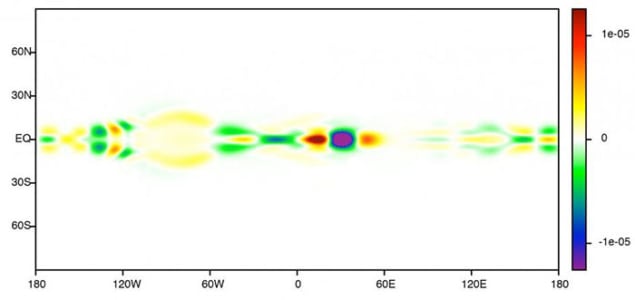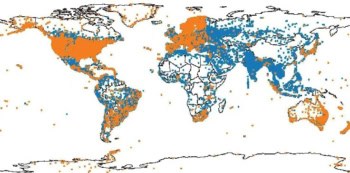
Topological water currents could exist in Earth’s oceans, according to physicists in the France and the US. The team has made a connection between the physics that gives topological insulators their unusual properties and Kelvin and Yanai waves – which exist in the oceans and atmosphere and are involved in regular variations of the Earth’s climate system.
Topological insulators are insulating materials that support electrical currents on their surfaces. They have captivated the imaginations of condensed-matter physicists because they offer ways of creating materials with new and potentially useful properties.
In topological insulators, the topology of the electron bands causes the electrons of opposite spin to move in opposite directions – resulting in circular motions. The effect is closely related to the so-called quantum Hall effect, which occurs in 2D conducting materials such as thin films in the presence of a magnetic field. The resulting circular motion permits no net flow of current through the material – except at the edges, where the circular orbits are truncated so that electrons can move around the surface in a series of arcs.
Topological protection
Because these motions arise from purely topological features of the electronic structure, they cannot easily be disrupted by defects: they are said to be “topologically protected”. Topological insulators are one of the most studied examples of so-called quantum materials, whose electronic or magnetic behaviour is strongly governed by quantum-mechanical effects. Some of these materials might find applications in, for example, quantum computing – but their chief attraction for physicists is that they unify a whole bunch of previously disparate concepts.
That unity reaches beyond materials science, according to Pierre Delplace and Antoine Venaille of the École Normal Supérieure de Lyon in France, working with Brad Marston of Brown University in Rhode Island. They say that two types of long-recognized wavelike flow in the atmosphere and oceans, called Kelvin and Yanai waves, also have a topological origin, which is mathematically analogous to the surface-conducting states of topological insulators.
This equivalence shows up in the mathematics of the problem, the researchers say. In condensed-matter physics, electron states are described by the wavelike Schrödinger equation. Orbits are created by the fact that an applied magnetic field breaks time-reversal symmetry: the solutions to the Schrödinger equation change when time t is replaced by –t. The surface electron flows then arise from a breakdown of translational symmetry that occurs at the surface.
Coriolis force
All these features, say Delplace and colleagues, are mimicked in the wave equations for flows in the atmosphere and oceans, where the Coriolis force – an effective force due to the Earth’s rotation that displaces flows to the right and left in the northern and southern hemispheres, respectively – plays the role of a magnetic field. These equations produce waves trapped close to the equator, always compelled to travel eastward, which are known as equatorial Kelvin and mixed Rossby-gravity (Yanai) waves.
Other such waves also exist, such as the long-period pure Rossby waves, but these are not “topologically protected” in the same way. Kelvin and Rossby waves can act as precursors to the quasi-periodic ocean-atmosphere oscillation called the El Niño Southern Oscillation, which produces significant climatic effects such as drought or high rainfall in some equatorial regions.
“A bit mysterious”
“The [theory of] equatorial waves was worked out in the 1960s but their topological origin went unnoticed until now,” says Marston. Instead, he says, the waves were seen simply as solutions to the shallow water equations near the equator – “but still they seemed a bit mysterious”.
The researchers spotted the connection, says Marston, through “intuition about the underlying physics” – particularly in the way that both magnetic fields and planetary rotation break time-reversal symmetry. It’s obvious once you’re attuned to the concepts of topological insulators, he says – all the recent candidates for a condensed-matter physics position at Brown immediately saw the link when shown the equations for Kelvin waves in an old geophysics textbook.
The resilience of such equatorial waves has been understood as a consequence of the mismatch in the dispersion (wavelength-frequency) relation between the equatorial waves, and other waves, Marston explains – “but now we can see that the mismatch is guaranteed by topology.” He adds: “I think the real consequences of topology remain to be discovered. Also there may be new types of waves with topological origin waiting to be found.”
Fresh perspective
Atmospheric scientist Isaac Held of the US National Oceanographic and Aeronautical Administration’s Geophysical Fluid Dynamics Laboratory at Princeton University agrees that this is a new interpretation of these equatorial waves. He thinks that the fresh perspective might help to understand why they are so robust, for example in the face of random noise in atmospheric or oceanic flows.
“This is really exciting work”, says physicist Sebastian Huber of the Swiss Federal Institute of Technology (ETH) in Zürich, who has previously demonstrated a mechanical analogue of topological insulators using an array of small pendulums. He says it reflects the “topological mindset” that physicists have acquired in recent years. “Many people tell me that our own mechanical set-up opened their eyes to the fact that the [vibration] band topology is not related to quantum mechanics but rather wave physics in general.”


